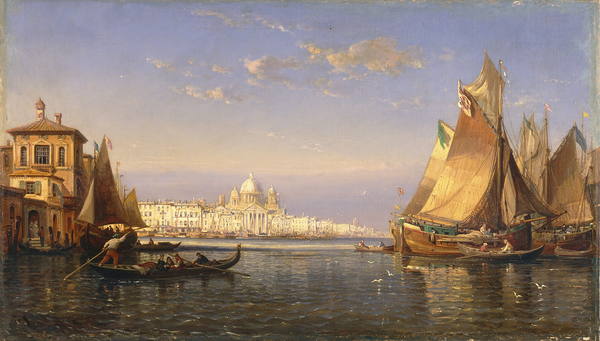Venice
Summary
A view across a wide canal, with boating activity, towards the line of the city on the horizon. To the left are elaborate waterside buildings; at the base of a flight of steps leading to the water from the buildings is gondola manned by two figures, standing at the top of the steps are two female figures; a larger sailing boat is moored in front of the buildings with a small vessel being rowed by its side. In the left foreground is a gondola being punted and rowed, carrying three other figures. Beyond, the water stretches into the background, extending towards the city bathed in light; moored boats line the shore behind which rise tall buildings, the domed roofs of a cathedral and the classical temple facade of a waterside building being particularly prominent. To the right are a group of large sailing boats at anchor, many with human activity, with smaller rowing boats travelling between them. Frame: gilt plaster, ornamented with a series of complex moulding strips with differing designs; softwood principal moulding with compo ornament and flat slip-frame with a bevelled sight-edge.
Display Label
Gallery text panel Expressing Passions Romanticism in Focus In 1772, Sir Joshua Reynolds told the Royal Academy that perfect works of art 'cannot express the passions'. Harmony, uniformity and restraint were preferred and there was little room for emotional content. This stress on classical qualities characterised the 1700s, echoing the stability and confidence of Georgian society. Artists of the early 1800s redressed the balance, placing human experience above artistic conventions and injecting greater personal vision into their work. This was largely in response to a more turbulent age of revolution, war and political reform. Uncertainty and rebellion were echoed in art through subjects representing disturbance and in an emphasis on individuality and imagination. The term Romanticism defines these developments. Although there was never an organised movement, there are distinctive hallmarks of Romantic art. These include a more direct response to nature and a new stress on colour as a means of expression. As artists became increasingly guided by their intuition, they grew more independent of patrons' demands: artistic freedom and experiment entered a new age.
Object Name
Venice
Creators Name
Date Created
1845-1855
Dimensions
Canvas: 57.5cm x 101.1cm
Frame: 92cm x 134cm
accession number
1917.155
Place of creation
England
Support
Canvas
Medium
Oil paint on canvas
Credit
Mr James Thomas Blair bequest, 1917.
Legal
© Manchester Art Gallery

